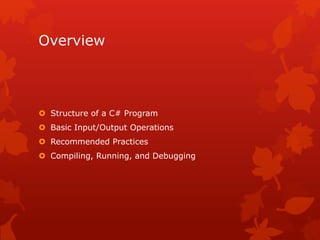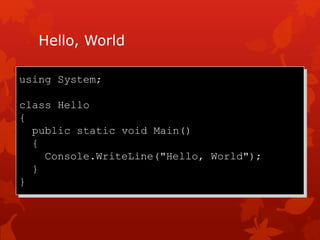Module 2: Overview of c#
- 2. Overview Structure of a C# Program Basic Input/Output Operations Recommended Practices Compiling, Running, and Debugging
- 3. Structure of a C# Program Hello, World The Class The Main Method The using Directive and the System Namespace Demonstration: Using Visual Studio to Create a C# Program
- 4. Hello, World using System; class Hello { public static void Main() { Console.WriteLine("Hello, World"); } }
- 5. The Class A C# application is a collection of classes, structures, and types A class Is a set of data and methods Syntax A C# application can consist of many files A class cannot span multiple files class name { ... }
- 6. The Main Method When writing Main, you should: Use an uppercase “M”, as in “Main” Designate one Main as the entry point to the program Declare Main as public static void Main Multiple classes can have a Main When Main finishes, or returns, the application quits
- 7. The using Directive and the System Namespace The .NET Framework provides many utility classes Organized into namespaces System is the most commonly used namespace Refer to classes by their namespace The using directive System.Console.WriteLine("Hello, World"); using System; … Console.WriteLine("Hello, World");
- 8. Basic Input/Output Operations The Console Class Write and WriteLine Methods Read and ReadLine Methods
- 9. The Console Class Provides access to the standard input, standard output, and standard error streams Only meaningful for console applications Standard input – keyboard Standard output – screen Standard error – screen All streams may be redirected
- 10. Write and WriteLine Methods Console.Write and Console.WriteLine display information on the console screen WriteLine outputs a line feed/carriage return Both methods are overloaded A format string and parameters can be used Text formatting Numeric formatting
- 11. Read and ReadLine Methods Console.Read and Console.ReadLine read user input Read reads the next character ReadLine reads the entire input line
- 12. Recommended Practices Commenting Applications Generating XML Documentation Demonstration: Generating and Viewing XML Documentation Exception Handling
- 13. Commenting Applications Comments are important A well-commented application permits a developer to fully understand the structure of the application Single-line comments Multiple-line comments /* Find the higher root of the quadratic equation */ x = (…); // Get the user’s name Console.WriteLine("What is your name? "); name = Console.ReadLine( );
- 14. Generating XML Documentation /// <summary> The Hello class prints a greeting /// on the screen /// </summary> class Hello { /// <remarks> We use console-based I/O. /// For more information about WriteLine, see /// <seealso cref="System.Console.WriteLine"/> /// </remarks> public static void Main( ) { Console.WriteLine("Hello, World"); } }
- 15. Exception Handling using System; public class Hello { public static void Main(string[ ] args) { try{ Console.WriteLine(args[0]); } catch (Exception e) { Console.WriteLine("Exception at {0}", e.StackTrace); } } }
- 16. Compiling, Running, and Debugging Invoking the Compiler Running the Application Demonstration: Compiling and Running a C# Program Debugging Demonstration: Using the Visual Studio Debugger The SDK Tools Demonstration: Using ILDASM
- 17. Invoking the Compiler Common Compiler Switches Compiling from the Command Line Compiling from Visual Studio Locating Errors
- 18. Running the Application Running from the Command Line Type the name of the application Running from Visual Studio Click Start Without Debugging on the Debug menu
- 19. Debugging Exceptions and JIT Debugging The Visual Studio Debugger Setting breakpoints and watches Stepping through code Examining and modifying variables
- 20. The SDK Tools General Tools and Utilities Windows Forms Design Tools and Utilities Security Tools and Utilities Configuration and Deployment Tools and Utilities
- 21. Review Structure of a C# Program Basic Input/Output Operations Recommended Practices Compiling, Running, and Debugging














![Exception Handling
using System;
public class Hello
{
public static void Main(string[ ] args)
{
try{
Console.WriteLine(args[0]);
}
catch (Exception e) {
Console.WriteLine("Exception at
{0}", e.StackTrace);
}
}
}](https://image.slidesharecdn.com/2overviewofc-190430132407/85/Module-2-Overview-of-c-15-320.jpg)





